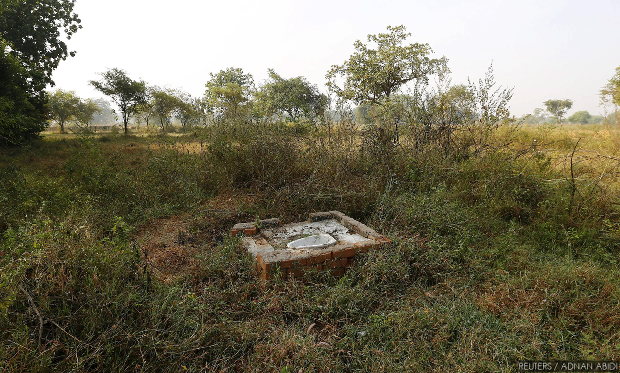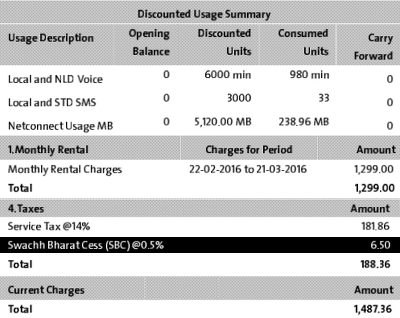New Cess Funds Toilets, Farmers, As Rs 1.3 lakh Cr Lies Unused
An open toilet in rural Chhattisgarh. More than 3.5 lakh toilets were built in the state in 2015-16.
The term "SBC"--appearing on restaurant, telephone and club bills nationwide--refers to the Swachh Bharat Cess, one of 10 levies that go directly to the central government and are expected to reach Rs 1.65 lakh crore ($25.3 billion) this financial year, 2016-17.
The Rs 1.65-lakh-crore cess-collection is an increase of 22% from 2015-16 and double the cess collection of Rs 83,000 crore ($12.7 billion) in 2014-15, according to an IndiaSpend analysis of budget data.
A warning over the use of these special taxes comes over the last decade, with at least Rs 1.3 lakh crore ($26 billion), or 41%, of cess collected but not used, according to this report from the government's auditor.
India's tax revenue is expected to increase 8.7%, from Rs 18 lakh crore ($277 billion) in 2015-16 to Rs 19.6 lakh crore ($301 billion, budget estimate) in 2016-17; so cess collection will likely grow faster.
Apart from SBC, or Clean India Cess, meant to finance Prime Minister Narendra Modi's favoured programme, other levies--lesser known siblings of taxes--are supposed to finance education, environment, agriculture, infrastructure, sanitation and communication.
As states get more money, Centre increases cess, which it does not share
The 14th Finance Commission recommended a transfer of 42% of tax revenue from Centre to states, up from 32%, stripping some of Centre’s revenues. To compensate, the Centre has increased cesses, which it does not need to share with the states.
Source: Union Budget 2016-17
“When more money is given to states, the union government will be short of revenue, and it may generate the required from tax instruments like cess, to achieve targeted spending on specific objectives,” Dharmakirti Joshi, chief economist at Crisil, a ratings agency, told IndiaSpend.
A cess is a tax that does not need a new law or act--and parliamentary approval--and is included in the Finance Act, meaning, through the budget.
Source: Union Budget 2016-17
While cesses for roads and sanitation have largely worked, those for secondary education, telecommunication, and research and development have not.
Success stories: Road cess, primary education cess, Swachh Bharat cess
A record Rs 73,000 crore ($11.2 billion) was generated in 2015-16 from road cess, an increase of 190% from Rs 25,121 crore ($3.9 billion) in 2014-15.
The tripling of road cess--which appears as additional excise duty on petrol and diesel--is due to the 75% drop in global oil prices, the benefits of which were kept by the government to address revenue concerns, as IndiaSpend reported earlier.
Source: Union Budget 2016-17
The estimate of road-cess collection in 2016-17 has increased marginally to Rs 78,000 crore ($12 billion), since there is no prospect of any further decline in global oil prices. The allocation for roads and bridges tripled over this period, from Rs 34,000 crore ($5.2 billion) in 2014-15 to Rs 1 lakh crore ($15.4 billion) in 2016-17 (budget estimate).
As much as 90% of the cess collected for primary education was transferred to Prarambhik Shiksha Kosh (Primary Education Fund), a fund specially created for primary education development. Between 2004-05 and 2014-15, Rs 1.4 lakh crore ($28 billion) from Rs 1.54 lakh crore ($31 billion) collected was used to fund primary education.
The Swachh Bharat cess was levied from November 2015 to ramp up toilet construction nationwide--nearly 16 million were constructed over two years, according to the government; 95 million need to be built over the next three--and meet the government's target of making India open-defecation free by 2019.
Source: Lok Sabha Question, answered by Minister of Drinking Water and Sanitation on 3rd March 2016
As of February 2016, about 10 million toilets were constructed since March 2015, up from 5.8 million in 2014-15 and five million in 2013-14.
Swachh Bharat cess levied in a telephone bill.
What did not work: Environment cess, secondary education cess
Since 2010-11, the government collected Rs 28,000 crore through the Clean Environment cess (earlier known as the Clean Energy Cess), but less than half the money was transferred to the National Clean Energy Fund to fund research and innovation.
Source: Report No. 50 of 2015 on Audit of Union Finances, Comptroller and Auditor General of India; Lok Sabha Question, answered by Minister for New and Renewable Energy on 10th March 2016
Note: NCEF = National Clean Energy Fund
Finance Minister Arun Jaitley doubled the clean environment cess—also known as coal cess—from Rs 200 per tonne to Rs 400 per tonne of coal, lignite and peat.
Less than half the cess collected—Rs 39,000 crore ($7.8 billion) from Rs 66,000 crore ($13.2 billion) between 2002-03 and 2014-15—to enhance communication services in rural regions was utilised.
As for the secondary and higher education cess, despite collecting Rs 64,000 crore ($13 billion) over the decade ending 2014-15, no special fund was created, and it isn't clear how the money was used.
Government auditor points to irregularities in using cess
Over the last two decades, no more than 41% of Rs 3.1 lakh crore ($62 billion) collected through four cesses was used, according to the Comptroller and Auditor General (CAG), the auditor of the government.
The CAG recently critiqued the central government—the Congress-led United Progressive Alliance, as well as the Bharatiya Janata Party-led National Democratic Alliance—for under-utilising cesses collected over the last two decades.
Of Rs 5,700 crore ($1.14 billion) collected as research and development cess, Rs 1,228 crore ($246 million), or 21%, was utilised over 18 years, from 1996-97 to 2014-15.
Source: Report No. 50 of 2015 on Audit of Union Finances, Comptroller and Auditor General of India
Note: Environment: 2010-11 to 2015-16, primary and secondary education: 2004-05 to 2014-15, R&D cess: 1996-97 to 2014-15, USO Fund: 2002-03 to 2014-15.
“The possibility of the diversion of funds for purposes not mandated under the Finance Act cannot be ruled out,” the CAG report said.
The last budget also increased service tax from 14.5% to 15% on select services by levying 0.5% Krishi Kalyan (farmers' benefit) Cess, which the government has promised to spend on agriculture.
“The use of cess should be temporary and with a specific purpose. If it is a permanent feature of the tax model, it is nothing but equivalent to a higher tax rate,” said Crisil's Joshi.
Indirect taxes are levied on both the rich and the poor alike, taxing those meant to be beneficiaries of such taxes.
---
Rupee to Dollar conversion rates: For last three years, 1$ = 65 INR; for amounts pertaining to past decades, 1$ = 50 INR has been used for approximation.
(Waghmare is an analyst with IndiaSpend.)
We welcome feedback. Please write to respond@indiaspend.org. We reserve the right to edit responses for language and grammar.
__________________________________________________________________
“Liked this story? Indiaspend.org is a non-profit, and we depend on readers like you to drive our public-interest journalism efforts. Donate Rs 500; Rs 1,000, Rs 2,000.”




